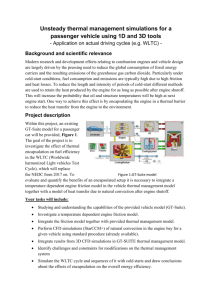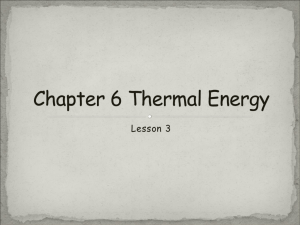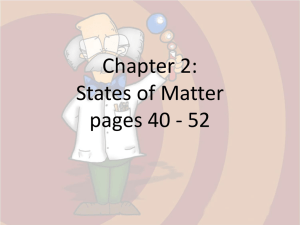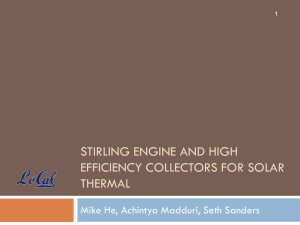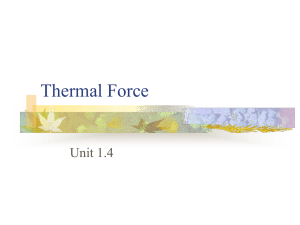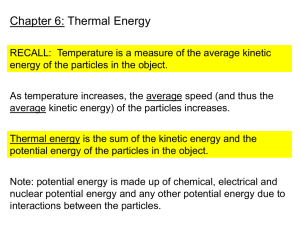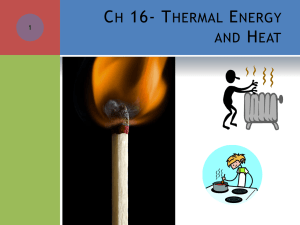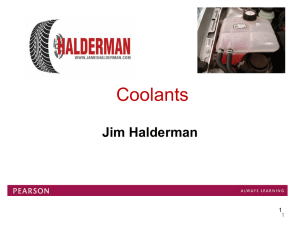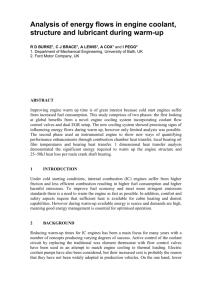Engines and refrigerators
advertisement
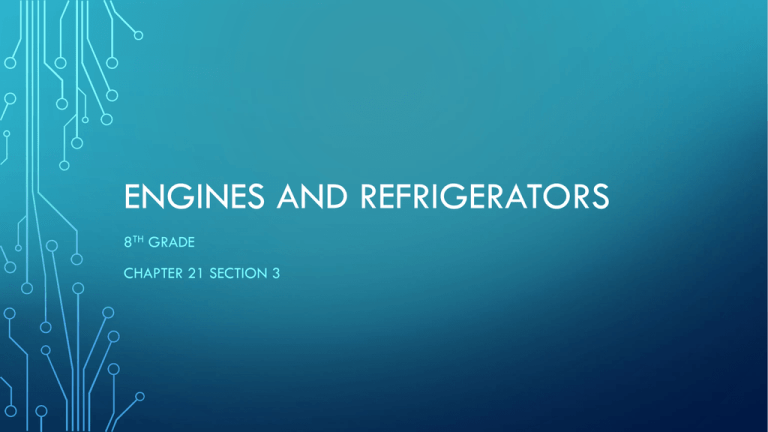
ENGINES AND REFRIGERATORS 8TH GRADE CHAPTER 21 SECTION 3 DO NOW… •In order to heat a room evenly, should heating vents be placed near the floor or near the ceiling? Explain. OBJECTIVES • Students will… • Describe what a heat engine does. • Explain that energy can exist in different forms, but is never created or destroyed. • Describe how an internal combustion engine works. • Explain how refrigerators move thermal energy. HEAT ABSORPTION • Specific Heat- is the amount of thermal energy needed to raise the temperature of 1kg of the substance by 1 degree C. • More thermal energy is needed to change the temperature of a material with a high specific heat than one with a low specific heat. • Ex: sand on a beach has lower specific heat than ocean water THERMAL POLLUTION • Thermal pollution- increase in the temperature of a body of water caused by adding warmer water. • Effects: organisms need more oxygen and warmer water has less dissolved oxygen=organisms die due to low oxygen. Also organisms are more sensitive to chemical pollutants, parasites and disease. • Reducing: Cooling warm water produced by factories, power plants and run off. HEAT ENGINES-DEVICES THAT CONVERT THERMAL ENERGY INTO MECHANICAL ENERGY. Types of Energy Chemical Energy—burning fuel Radiant Energy—heat from a fire Nuclear Energy– splitting atoms in a power plant Electrical Energy-lightning Thermal Energy-energy in a hot cup of tea Mechanical energy-Moving Train THE LAW OF CONSERVATION OF ENERGY • When energy is transformed from one form to another, the total amount of energy doesn’t change. • Energy cannot be created or destroyed. • Energy only can be transformed from one form to another. • No device (even a heat engine) can produce or destroy energy. INTERNAL COMBUSTION ENGINE • A heat engine in which fuel burns in a combustion chamber inside the engine. • Examples: cars, airplanes, buses, boats, trucks and lawn mowers. • Most modern cars are powered by fuel-injected internal combustion engines that have a 4 stroke combustion cycle. • Inside the engine, thermal energy is converted into mechanical energy as gas is burned under pressure inside the chambers known as cylinders. STEPS IN THE FOUR-STROKE CYCLE (FOLDABLE) • 1) Intake Stroke • - The piston moves downward. • -Air fills the cylinder through the intake valve. • -A mist of fuel is injected into the cylinder. • 2) Compression Stroke • -The piston moves upward, compressing the fuel-air mixture. STEPS IN THE FOUR-STROKE CYCLE • 3) Power Stroke • -A spark from the spark plug ignites the fuel-air mixture. • - The hot gases expand, pushing the piston down and turning the crankshaft. • 4) Exhaust Stroke • - The exhaust valve opens as the piston moves up. Exhaust gases are forced out of the cylinder. VIDEOS • Heat as Energy (eureka) • 4 Stroke Cycle FOR NEXT TIME… •Read pgs. 619-623 •Define work, heat engine, and internal combustion engine. ENGINES AND REFRIGERATORS 8TH GRADE CHAPTER 21 SECTION 3 DO NOW… •Name the steps in the 4 stroke cycle. •Heat as Energy (eureka OBJECTIVES •Students will… •Explain how refrigerators move thermal energy. REFRIGERATORS (GIVE OUT WORKSHEET) • A refrigerator is a heat mover. • It absorbs thermal energy from the food inside the fridge and then it carries the thermal energy to outside the refrigerator where it is transferred to the surrounding air. • A refrigerator contains a material called a coolant that is pumped through the pipes inside and outside the fridge. • The coolant is the substance that carries thermal energy from the inside to the outside of the refrigerator. AIR CONDITIONERS AND HEAT PUMPS • AC units cool in a similar manner to refrigerators. • Thermal energy from inside the house is absorbed by the coolant within the pipes inside the air conditioner. • The coolant becomes compressed by a compressor and becomes warmer. • Then the warmed coolant travels through pipes that are exposed to the outside air. HEAT PUMPS (HEATING/COOLING) • A heat pump moves thermal energy from one place to another. • Heating mode: coolant absorbs thermal energy through outside coils. The coolant is warmed when it is compressed and transfers thermal energy to the house through the inside coils. • Cooling mode: It removes thermal energy from the indoor air and transfers it outdoors. BILL NYE: ENERGY • Bill Nye Energy FOR NEXT TIME… • Read pg. 626 • Answer: What factors need to be considered when planning expansion of cities? REVIEWING THERMAL ENERGY 8TH GRADE DO NOW… • What factors need to be considered when planning expansion of cities? • Review homework OBJECTIVES •Students will… •Begin to review chapter 21 thermal heat CHAPTER 21 REVIEW PACKET • Begin working on review packet for Chapter 21. • Review packet (all 3 pages) needs to be completed by Tuesday. • Reminder guest speakers on Monday.

